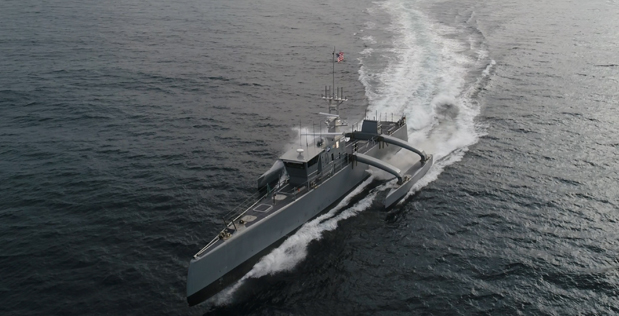
Naval warfare could be on the brink of a total makeover through cutting-edge technology and innovation. Making waves at the center is the Sea Hunter – a new breed of unmanned, autonomous vessels launched in 2016. It forms part of the DARPA Anti-Submarine Warfare Continuous Trail Unmanned Vessel (ACTUV) program. DARPA has already completed trials of a prototype unmanned submarine hunter and claims it could lead to a new class military vessel.
Initial Unmanned Sea Trials
On 22 June 2016, Sea Hunter completed initial performance trials and in doing so, met and surpassed all performance objectives. These included speed, maneuverability, stability, sea-keeping, acceleration and deceleration, fuel consumption and mechanical systems reliability in open waters. The autonomous vessel also had a successful joint test with DARPA’s Towed Airborne Lift of Naval Systems (TALONS) research effort. They were exploring the use of a towed parafoil to enable vessels to see over the horizon.
Subsequent trials included testing of sensors, the vessel’s autonomous capabilities and proof-of-concept demonstrations. In fact, the Sea Hunter recently underwent numerous tests to ensure it complies with maritime collision regulations. They also conducted at-sea tests involving a mine countermeasure (MCM) payload with great success.
The US Office of Naval Research (ONR) plans on further development in 2018. These advancements include adding intelligence, surveillance and reconnaissance (ISR) and offensive anti-submarine payloads.
Operating Autonomous Vessels
The Sea Hunter is at the heart of efforts to develop a new type of unmanned surface vessel (USV) that would autonomously track enemy submarines over thousands of miles at a fraction of current costs. Operating a destroyer costs $700 000 per day where autonomous vessels like Sea Hunter could be between $15 000 and $20 000.
Although the initial prototype is unarmed, the Sea Hunter could be armed for anti-submarine and counter-mine duties. It could operate with Littoral Combat Ships, becoming an extension of the LCS ASW module. With all the controversy surrounding robotics, artificial intelligence and machine learning, it’s no surprise that Deputy US Defense Secretary Robert Work said the following:
“If weapons are added to the ship, a human would always remotely make the decision to use lethal force.”
Operationally, computers will drive and control the ship but a human is always observing and taking charge if necessary. This concept is called Sparse Supervisory Control, meaning a person is in control, but not actively maneuvering the autonomous vessels. It can patrol without human intervention for months using optical guidance and radar to avoid hitting obstacles or other ships.
As the Sea Hunter operates autonomously without crew on board, it could ultimately replace the need for larger manned warships. Fred Kennedy, director of DARPA’s Tactical Technology Office said that ACTUV represents a new vision of naval surface warfare. He believes it’s the first step toward replacing ‘king’ and ‘queen’ pieces on the maritime chessboard with lots of ‘pawns’.
Performance, Specifications and Aspirations
The Sea Hunter prototype is a 132-foot (40m) long trimaran – a central hull with two outriggers. It provides increased stability without requiring a weighted keel which results in a higher capacity for linear trajectories. Although it fares better in shallow waters, the greater width decreases maneuverability.
Two diesel engines power twin screws enabling the craft to reach a top speed of 27 knots (31 mph; 50 km/h). Total weight is 135 tons and includes 40 tons of fuel which is adequate for a 70-day cruise. Reports suggest it has a ’transoceanic’ range of 10 000 nautical miles (12 000 miles, 18 520 km) at 12 knots or 14 mph (22.2 km/h).
Additional at-sea tests are planned to further develop the Sea Hunter including exploring autonomous coordination with multiple USV’s. If all tests are successful, we could see autonomous vessels like the Sea Hunter entering service this year.
Share your thoughts on autonomous vessels in the section below or comment on social media using our new hashtag #PRVtech. We’d love to hear from you. Please find us on Twitter, Facebook, YouTube, Google+ or LinkedIn.
Contact us via the website if you have any questions about PRV Engineering and how we can help with your manufacturing project.
This site uses Akismet to reduce spam. Learn how your comment data is processed.


 Mail:
Mail: 




Leave a Comments